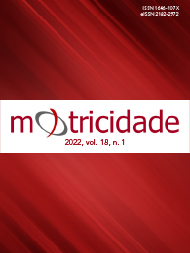Body Image, Muscle Dysmorphia, and Muscularity Concerns: A Comparison of CrossFit Athletes, Weight-Trainers, and Non-Athletes
DOI:
https://doi.org/10.6063/motricidade.25584Palavras-chave:
Body appreciation, Body dissatisfaction, Sport, Physical activity, Muscle concernsResumo
CrossFit is a strength-and-conditioning physical activity programme that some studies have shown results in healthier body image outcomes. However, prior studies have typically examined CrossFit in isolation, without adequate group comparison. This study aimed to investigate body image experiences in CrossFit athletes in comparison to weight-trainers and non-athletes. The study used a cross-sectional design in which CrossFit athletes, weight-trainers, and non-athletes from Brazil were asked to complete a measure of positive body image (i.e., body appreciation), negative body image (i.e., body dissatisfaction), and gender-specific muscle-oriented body image (i.e., muscularity concerns in women and muscle dysmorphia symptomatology in men). Between-group comparisons showed that CrossFit athletes and weight-trainers had healthier body image than non-athletes, but differences between the two groups were small. There were no significant between-group differences in muscularity concerns in women, whereas weight-training men had a significantly higher drive for size compared to both CrossFit athletes and non-athletes. Male CrossFit athletes and weight-trainers also showed significantly higher functional impairment as a result of exercise compared to non-athletes. These results suggest that participation in CrossFit may be a route to promoting a healthier body image while mitigating unhealthy muscularity-related attitudes and behaviours. More broadly, our results support the suggestion that physical activity is associated with a healthier body image.
Keywords: Body appreciation; Body dissatisfaction; Sport; Physical activity; Muscle concerns; CrossFit
Downloads
Publicado
Edição
Secção
Licença
Os autores dos manuscritos submetidos para publicação deverão ceder, a título integral e permanente, os direitos de autor (copyright) à revista Motricidade e às Edições Sílabas Didáticas. A cedência de direitos de autor permite a publicação e divulgação do artigo em formato impresso ou eletrónico e entrará em vigor a partir da data de aceitação do manuscrito. Os autores concedem, ainda, os direitos para a revista Motricidade utilizar e explorar o respetivo artigo, nomeadamente para licenciar, ceder ou vender o seu conteúdo a bases de resumos/indexação ou outras entidades.
Nos termos da licença “Creative Commons”, os autores poderão reproduzir um número razoável de exemplares para uso pessoal ou profissional, mas sem fins comerciais. Nos termos da licença SHERPA/RoMEO, os autores poderão, ainda, disponibilizar/arquivar uma cópia digital final (versão postprint) do artigo no seu website ou no repositório científico da sua instituição.


